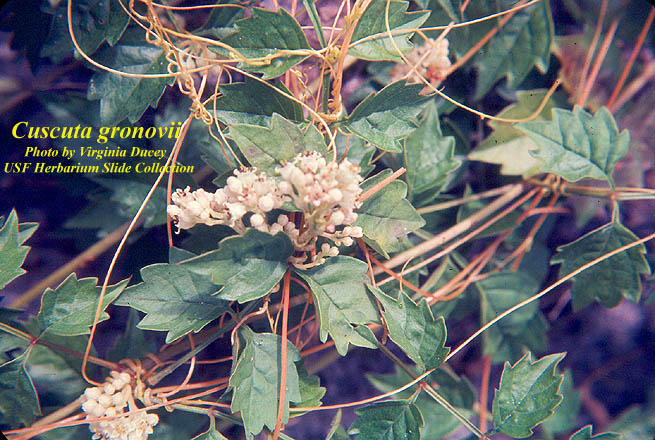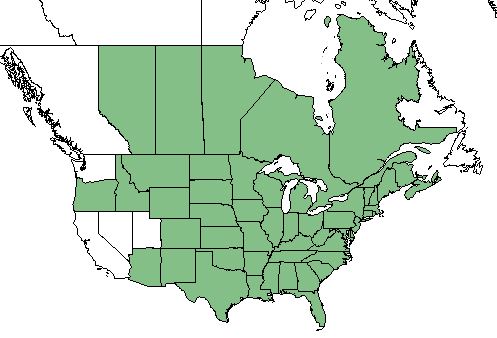Cuscuta gronovii
| Cuscuta gronovii | |
|---|---|

| |
| Photo by the Atlas of Florida Plants Database | |
| Scientific classification | |
| Kingdom: | Plantae |
| Division: | Magnoliophyta - Flowering plants |
| Class: | Magnoliopsida - Dicots |
| Order: | Solanales |
| Family: | Cuscutaceae |
| Genus: | Cuscuta |
| Species: | C. gronovii |
| Binomial name | |
| Cuscuta gronovii Willd | |

| |
| Natural range of Cuscuta gronovii from USDA NRCS Plants Database. | |
Common Name: Swamp Dodder; Common Dodder;[1] Scaldweed[2]
Contents
Taxonomic Notes
Synonyms: Grammica gronovii (Willdenow ex Roemer & J.A. Schultes) Hadac & Chrtek.[3]
Varieties: none.[3]
Description
Cuscuta gronovii is a dioecious perennial in the Convolvulaceae family that grows as a forb/herb or vine.[2] Stems range in color from bright orange to yellow, which wither between inflorescences as the fruit matures. The inflorescence consists of 6 to 18 flowers.[4] Scales can produce up to five axillary branches, which can then become their own plant after contacting a host.[5] Its seeds weight 2.3 g and is reported to have 22,900 seeds in a single clump.[6] Although, seed production may also be influenced by the species its host (as cited in [7]). Other dodder species have a very limited photosynthetic ability that decreases with age. It is likely C. gronovii is similar in this regard.[8]
Distribution
It is the most widespread species of the Cuscuta genus.[9] This species is found in all of the lower 48 United States except for Washington, California, Nevada, and Utah. It is also found in Canada from Alberta eastward to Quebec, New Brunswick, and Nova Scotia.[2] C. gronovii has also been introduced in Europe.[10]
Ecology
Species in the Cuscuta genus are parasitic, growing and depending on other species for nutrients. Cuscuta gronovii is a generalist, able to use a large range of hosts in the following families: Acanthaceae, Anacardiaceae, Apiaceae, Asteraceae, Bignoniaceae, Brassicaceae, Caprifoliaceae, Commelinaceae, Convolvulaceae, Cornaceae, Balsaminaceae, Betulaceae, Euphorbiaceae, Fabaceae, Lamiaceae, Polygonaceae, Primulaceae, Rosaceae, Rubiaceae, Solanaceae, Urticaceae, Verbenaceae, and Vitaceae.[9]
Habitat
This species is found on a wide variety of herbaceous and woody plants within stream banks, bottomland forests, bogs, marshes, swamps, wet fields, and wet disturbed areas.[1] C. gronovii has also been observed in pine-oak woods, and open slopes, and has been seen growing on Helianthus and other composites, legumes, and Campsis species.[11]
Phenology
Flowering occurs from late July through November in the southeastern and mid-Atlantic United States.[1]
Seed bank and germination
C. gronovii seeds are known to survive in dry storage for up to 30 years and a 12 year study in simulated bog environments supports such lengthy longevity in the seed bank (reviewed in [7]). Germination in the top 2 cm of soil were significantly higher in a Delaware non-flooded bog (4,470 seedlings m-2) than flooded (205 seedlings m-2).[12] Seeds germinate in soil, but roots die off as the plant twines around a host and sends out suckers that penetrate the host's tissues and obtain nutrients.[13] While searching for a host, seedlings have shown a preference for taller hosts (as cited in [7]). Embryogenesis studies reveal no primary root meristem in this species.[5] One study found that manual scarification of the seeds significantly increased the amount of water uptake as well as seed germination rates, and seeds germinated within four months regardless of temperature.[14] However, another study found seeds of C. gronovii to germinate best between 22 and 23 degrees Celsius.[4]
Fire ecology
Because scarification increases the germination rate of C. gronovii (reviewed in [7]), fire has the potential to increase the abundance of C. gronovii.
Pollination
C. gronovii is visited by plasterer bees from the Colletidae family (Hylaeus annulatus and Hylaeus mesillae), sweat bees from the Halictidae family (Halictus rubicundus and Lasioglossum sp.) and plant bugs from the Miridae family (Lygus lineolaris).[15]
Conservation, cultivation, and restoration
Other than widely distributed species or native species, the genus Cuscuta is listed as a noxious weed, a pest, and even prohibited or quarantined by the U.S. federal government as well as the following states: Alabama, Arizona, Arkansas, California, Florida, Massachusetts, Michigan, Minnesota, North Carolina, Oregon, South Carolina, South Dakota, and Vermont.[2] For management, one technique to reduce the emergence of C. gronovii is to bury seeds under at least 2.5 cm of sand.[16] The use of glyphosate on glyphsate-resistant crops are reported to effectively control dodder.[17] Additionally, ethephone showed a limited effect on C. gronovii, regardless of concentration (as cited in [7]).
Cultural use
Photo Gallery
References and notes
- ↑ 1.0 1.1 1.2 Weakley AS (2015) Flora of the Southern and Mid-Atlantic States. Chapel Hill, NC: University of North Carolina Herbarium.
- ↑ 2.0 2.1 2.2 2.3 USDA NRCS (2016) The PLANTS Database (http://plants.usda.gov, 25 January 2018). National Plant Data Team, Greensboro, NC 27401-4901 USA.
- ↑ 3.0 3.1 Weakley, A.S. 2015. Flora of the southern and mid-atlantic states. Working Draft of 21 May 2015. University of North Carolina at Chapel Hill, Chapel Hill, North Carolina.
- ↑ 4.0 4.1 Musselman, L. J. (1986). "The genus Cuscuta in Virginia." Castanea 51(3): 188-196.
- ↑ 5.0 5.1 Truscott FH (1966) Some aspects of morphogenesis in Cuscuta gronovii. American Journal of Botany 53(7):739-750.
- ↑ Stevens OA (1957) Weights of seeds and numbers per plant. Weeds 5(1):46-55.
- ↑ 7.0 7.1 7.2 7.3 7.4 Sandler HA (2010) Managing Cuscuta gronovii (swamp dodder) in cranberry requires an integrated approach. Sustainability 2:660-683.
- ↑ Pattee HE, Allred KR, Wiebe HH (1965) Photosynthesis in dodder. Weeds 13(3):193-195.
- ↑ 9.0 9.1 Costea, M., G. L. Nesom, and S. Stefanovic. (2006). "Taxonomy of Cuscuta gronovii and Cuscuta umbrosa (Convolvulaceae)." SIDA Contributions to Botany 22(1): 197-207.
- ↑ Austin, D. F. (1980). "Studies of the Florida Convolvulaceae - III. Cuscuta." Florida Scientist 43(4): 294-302.
- ↑ Florida State University Robert K. Godfrey Herbarium database. URL: http://herbarium.bio.fsu.edu. Last accessed: April 2019. Collectors: Loran C. Anderson, Bob Farley, R. A. Norris, Peter H. Raven, and Tamra Engelhorn Raven. States and Counties: Florida: Jackson, Jefferson, Leon, and Taylor.
- ↑ Leck MA, Simpson RL (1987) Seed bank of a freshwater tidal wetland: Turnover and relationship to vegetation change. American Journal of Botany 74(3):360-370.
- ↑ Plant database: Cuscuta gronovii. (25 January 2018) Lady Bird Johnson Wildflower Center. URL: https://www.wildflower.org/plants/result.php?id_plant=CUGR
- ↑ Jayasuriya, K. M. G. G., et al. (2008). "Dormancy, germination requirements and storage behaviour of seeds of Convolvulaceae (Solanales) and evolutionary considerations." Seed Science Research 18: 223-237.
- ↑ Discoverlife.org [1]
- ↑ Sandler HA, Else MJ, Sutherland M (1997) Application of sand for inhibition of swamp dodder (Cuscuta gronovii) seedling emergence and survival on cranberry (Vaccinium macrocarpon) bogs. Weed Technology 11:318-323.
- ↑ Bewick TA, Binning LK, Dana MN (1988) Postattachment control of swamp dodder (Cuscuta gronovii) in cranberry (Vaccinium macrocarpon) and carrot (Daucus carota). Weed Technology 2:166-169.